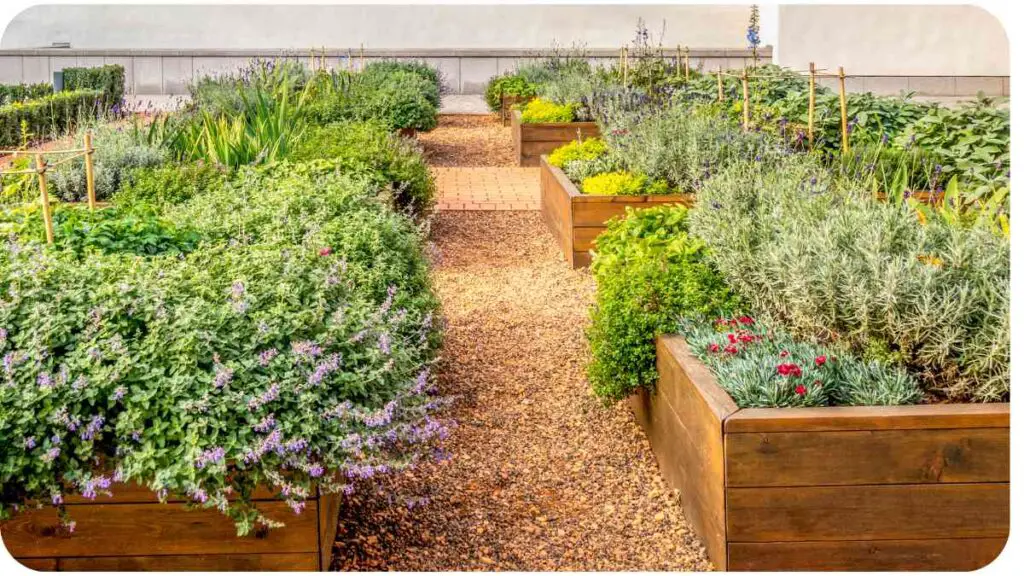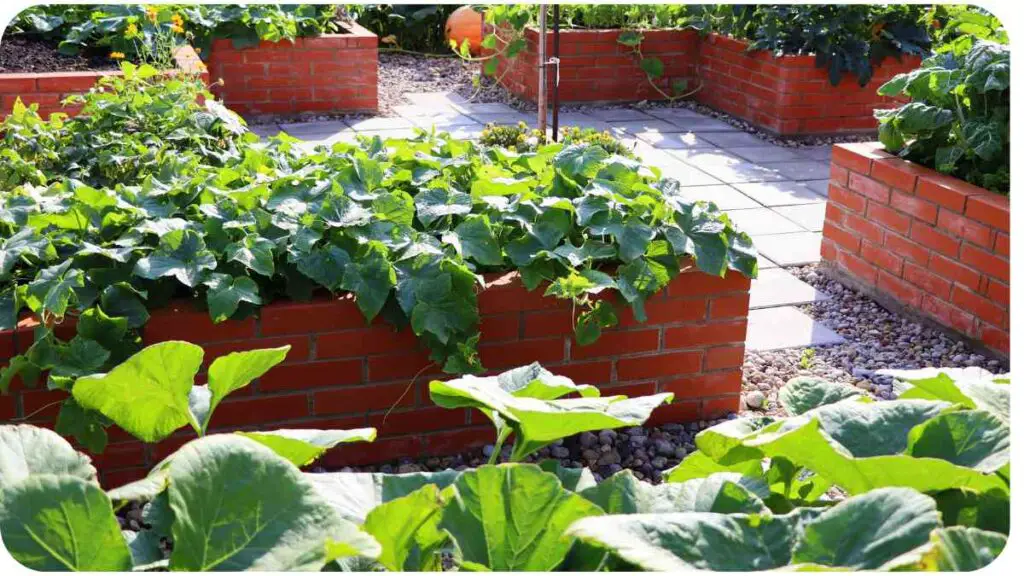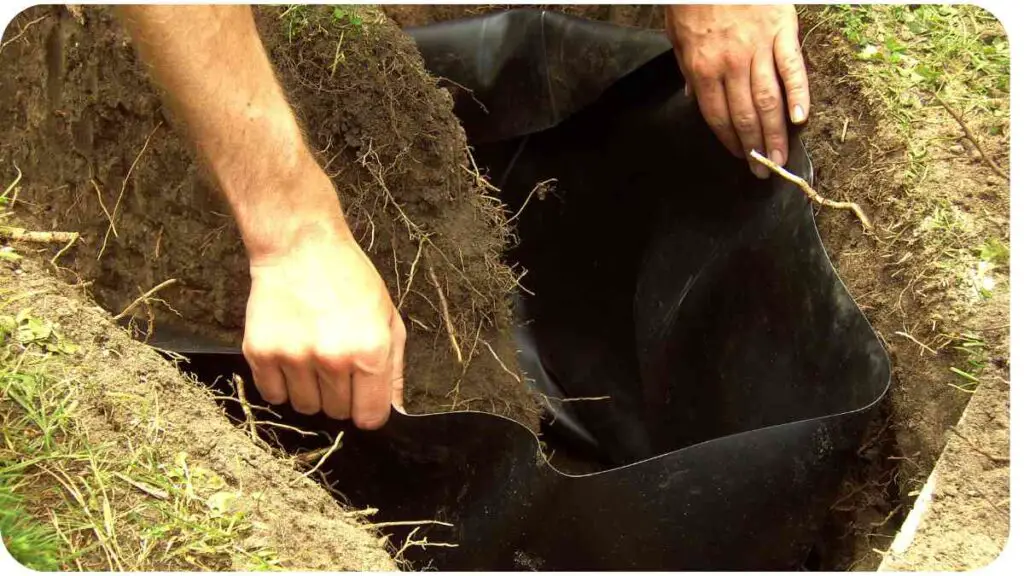Raised garden beds are elevated plots of soil contained within a frame, typically made from wood, stone, or metal. They offer a host of benefits such as improved drainage, better control over soil quality, and easier access for planting, weeding, and harvesting. I’ve built several raised garden beds in my backyard, and trust me, they make gardening much more enjoyable no more kneeling for hours in the dirt!
But as great as raised garden beds are, they’re not without challenges. One of the most frustrating problems? Root invasion. Let’s dive into what that is and how to deal with it.
| Key Takeaways |
|---|
| Root invasion can significantly harm the plants in your raised beds. |
| Installing root barriers is a highly effective method to prevent root invasion. |
| Raised bed liners, deep digging, and metal edging offer alternative prevention. |
| Regular maintenance is essential to keep roots from infiltrating garden beds. |
| Plants like lavender, thyme, and dwarf fruit trees are resistant to root invasion. |
| Manual root removal and root pruning are viable methods for dealing with existing root invasion. |
| Using chemical barriers should be a last resort and done with care. |
What Is Root Invasion?
Root invasion happens when the roots of nearby trees, shrubs, or aggressive plants extend into your raised bed and compete with your garden plants for water and nutrients. It’s a slow process that can go unnoticed until it’s too late. I remember once neglecting the space near a large tree, only to discover its roots had found their way into my raised bed, suffocating the plants I had carefully nurtured.
Addressing root invasion in raised garden beds often requires understanding and solving broader issues. For more on this topic, check out our guide on troubleshooting stunted growth in raised beds.
How Root Invasion Affects Raised Garden Beds

When root invasion occurs, the roots of invasive plants can overpower the roots of the plants in your raised bed. This leads to:
- Stunted plant growth: Your garden plants will struggle to access the nutrients they need.
- Crowded soil: The invading roots take up space, limiting the root systems of your garden plants.
- Water competition: Invasive roots soak up moisture, leaving little for your plants.
The results are frustrating your garden might look healthy from the surface, but underneath, a battle is brewing.
Identifying Signs of Root Invasion
4.1 Stunted Growth of Plants
One of the first signs that you may have a root invasion problem is when plants in your raised garden bed stop growing or grow much more slowly than expected. This is often a sign that they’re not getting the nutrients they need.
Root invasion can lead to poor soil conditions. To find solutions for improving your garden bed’s soil, refer to our article on soil not draining: solutions for soggy garden beds.
4.2 Unusual Root Patterns
When you pull up plants, you may notice that their roots are smaller or oddly shaped. This can be due to them having to fight for space with invasive roots from nearby plants.
4.3 Soil Changes
Soil may feel more compacted or harder than usual, making it more difficult for plants to establish healthy root systems.
Common Plants and Trees Causing Root Invasion

5.1 Invasive Tree Species
Trees like poplars, willows, and maples have aggressive root systems that can invade your raised beds if planted nearby. Their roots tend to search for water and nutrients far from the base of the tree, which is bad news for nearby garden beds.
Plants affected by root problems might show symptoms similar to those of nutrient issues. Learn more about how to address plant health with our article on addressing color loss in ornamental grasses.
5.2 Aggressive Shrubs
Shrubs like bamboo and ivy can also be culprits. They spread fast and send out roots that are more than happy to infiltrate your well-kept garden beds.
Table: Common Plants and Trees That Cause Root Invasion
| Plant/Tree | Root Characteristics | Distance to Keep from Raised Beds |
|---|---|---|
| Poplar Tree | Aggressive, far-reaching | 50 feet or more |
| Willow Tree | Spreads towards water | 40 feet or more |
| Bamboo | Fast-spreading rhizomes | 20 feet with barriers |
| Ivy | Spreads underground | 15 feet or use root blockers |
Preventing Root Invasion in Raised Beds
6.1 Proper Raised Bed Construction
To stop root invasion before it begins, it all starts with building your raised beds properly. Make sure to elevate them enough to create a clear separation from ground-level plants and trees. In my own backyard, I found that a bed height of about 18-24 inches was perfect for preventing roots from finding their way into the bed.
6.2 Root Barriers
Installing a physical barrier between the ground and your raised bed is one of the most effective ways to stop root invasion. Root barriers made from plastic or metal work wonders.
6.3 Strategic Planting Choices
Choose to plant your raised beds away from trees or shrubs known to have aggressive root systems. Trust me, it’s worth thinking ahead about which plants can become a headache down the line.
Table: Root Barrier Materials for Raised Garden Beds
| Material | Durability | Ease of Installation | Cost |
|---|---|---|---|
| Plastic Sheets | High | Easy | Affordable |
| Metal | Very High | Moderate | Expensive |
| Geotextile | Moderate | Easy | Affordable |
Best Materials for Root Barriers

There are a few materials that work best for creating barriers between the soil in your raised beds and the surrounding area. These include:
- Plastic sheets: Affordable and easy to install, but they may degrade over time.
- Metal: Long-lasting but can be more expensive and requires careful installation.
- Geotextile fabric: Durable and allows for drainage while blocking roots.
If you’re dealing with root invasion in vertical garden setups, you might find helpful insights in our guide on common challenges with vertical gardens and how to fix them.
Installing Root Barriers: A Step-by-Step Guide
To properly install a root barrier, follow these steps:
- Dig around the perimeter of your raised bed to a depth of about 18-24 inches.
- Insert the root barrier material into the trench, making sure it extends above ground level.
- Secure the barrier by backfilling the trench with soil, ensuring there are no gaps.
- Check the edges regularly for wear and tear, especially with plastic barriers.
Alternative Methods to Combat Root Invasion
Sometimes, root barriers aren’t the best fit for your garden, or you may want additional layers of protection. Luckily, there are alternative methods that can be just as effective in preventing root invasion.
9.1 Raised Bed Liners
A raised bed liner, such as heavy-duty landscape fabric, can provide an extra shield between your plants and invasive roots. These liners are breathable, allowing water to pass through but keeping roots at bay. I’ve used landscape fabric in several of my raised beds, and it’s a great solution, especially if you’re dealing with aggressive plants.
9.2 Deep Digging and Trenching
Another method involves digging a deep trench around your raised bed, acting as a root-free moat. This method requires consistent upkeep, but if done correctly, it can prevent roots from creeping into your bed.
9.3 Using Metal or Plastic Edging
Metal or plastic edging can be installed around the perimeter of your raised bed. While not as deep as root barriers, this method can still discourage some roots from finding their way into your garden. The key here is consistency check for signs of root growth and reapply edging when necessary.
Table: Comparison of Alternative Root Invasion Prevention Methods
| Method | Effectiveness | Ease of Maintenance | Cost |
|---|---|---|---|
| Raised Bed Liners | High | Moderate | Affordable |
| Deep Digging & Trenching | Moderate | Labor-intensive | Low |
| Metal/Plastic Edging | Moderate | Low | Affordable |
How to Deal with Existing Root Invasion
Already dealing with root invasion? Don’t worry, there are steps you can take to reclaim your garden. Root invasion can be stubborn, but with the right approach, you can restore your raised bed to its former glory.
Effective soil management can help mitigate root invasion issues. Explore strategies for managing soil with our article on soil erosion solutions for sloped landscapes.
10.1 Manual Root Removal
One of the most straightforward methods is to manually remove the roots. Grab a sharp spade or root saw and dig around the invaded area, cutting away the offending roots. This method requires physical effort but is often effective, especially for small to medium-sized roots.
10.2 Chemical Methods
There are chemical root barriers that can be applied to prevent regrowth after roots have been removed. Herbicides, such as glyphosate, can be used in non-growing areas to stop roots from extending back into your bed. Use chemicals sparingly and as a last resort, ensuring they don’t harm the plants you want to keep.
10.3 Using Root Pruning Techniques
Root pruning is the act of cutting back the roots of nearby trees or shrubs. While this doesn’t permanently solve the problem, it does offer a temporary reprieve, allowing your garden plants to grow without immediate competition. I’ve found that periodic root pruning every few months can work wonders, especially if you stay on top of it.
Table: Methods for Dealing with Existing Root Invasion
| Method | Pros | Cons |
|---|---|---|
| Manual Root Removal | Immediate and effective | Labor-intensive and time-consuming |
| Chemical Methods | Long-lasting, prevents regrowth | Can harm surrounding plants, requires caution |
| Root Pruning | Provides temporary relief | Needs regular upkeep |
Top Plants Resistant to Root Invasion
Sometimes, the best way to deal with root invasion is to prevent it by choosing the right plants for your raised beds. Some plants are naturally more resistant to invasive roots and can thrive even in less-than-ideal conditions. Here are a few that have worked well in my own garden:
- Lavender: Not only is it beautiful and fragrant, but lavender is also highly resistant to root invasion.
- Thyme: A low-maintenance herb that grows well in raised beds and can hold its own against nearby root systems.
- Dwarf fruit trees: Dwarf varieties of apple, pear, and cherry trees have smaller, more contained root systems, making them perfect for raised beds.
- Perennial flowers: Plants like echinacea, black-eyed Susans, and daylilies are hardy and less likely to succumb to root competition.
Table: Top Plants Resistant to Root Invasion
| Plant | Resistant Qualities | Ideal Conditions |
|---|---|---|
| Lavender | Deep roots, thrives in poor soils | Full sun, well-drained soil |
| Thyme | Shallow root system, tolerates dry conditions | Full sun, sandy or loamy soil |
| Dwarf Apple Tree | Smaller root systems, manageable growth | Full sun, well-drained soil |
| Black-eyed Susan | Tough perennial, can compete with nearby roots | Full sun, adaptable to most soils |
Maintaining Raised Garden Beds After Root Invasion Prevention
Once you’ve implemented your root invasion prevention strategies, it’s important to maintain your raised garden beds to keep them thriving. Regular maintenance ensures that your hard work doesn’t go to waste.
- Monitor the soil: Check the soil’s health regularly, especially after heavy rain or drought, to make sure roots aren’t sneaking in.
- Prune nearby trees: If you’ve got trees near your garden beds, make a habit of pruning their roots and branches to limit their reach.
- Reinforce barriers: Every year or so, inspect your root barriers for any damage and replace or repair as needed.
Root Invasion FAQs
Q: How deep should a root barrier be installed for raised beds?
A: A root barrier should be installed at least 18-24 inches deep to effectively block invasive roots.
Q: Can I use natural materials like mulch as a root barrier?
A: While mulch is great for retaining moisture, it won’t stop aggressive roots from entering your raised bed. You’ll need something more solid like plastic or metal.
Q: How do I know if my raised bed is being affected by root invasion?
A: Look for signs like stunted plant growth, changes in soil texture, or smaller, malformed roots when you dig up plants.
Q: Can I build a raised garden bed directly on top of tree roots?
A: It’s not recommended. Even if the tree roots aren’t affecting your garden bed initially, they will likely find their way in over time.
Q: Is root invasion a problem for all raised beds?
A: No, it depends on the proximity of nearby trees or aggressive plants. However, it’s always a good idea to plan ahead and take preventive measures.
Conclusion
Root invasion can be a headache, but with the right preparation and preventive strategies, you can keep your raised garden beds flourishing. By choosing the right plants, installing barriers, and maintaining your beds, you’ll ensure that your garden remains a place of growth and beauty. Whether you’re new to gardening or a seasoned pro, these tips will help you overcome the challenges of root invasion and enjoy a thriving garden all year long.
Further Reading
- Root Invasion Problems in Gardens
This article from Green Life Soil offers sustainable gardening tips to prevent root invasion and maintain a healthy garden. - Tree Roots Invading Your Vegetable Garden
Love of Dirt provides an insightful look into how tree roots can invade vegetable gardens and offers organic solutions to combat the issue. - Rebuilding Raised Garden Beds: Battling Root Invasion
Learn from a real-life experience of dealing with root invasion in raised beds as shared on the Lewisham House blog.
FAQs
How do I prevent root invasion in my raised garden beds?
To prevent root invasion, install a root barrier around your garden bed. You can use materials like plastic or metal sheets, or even dig a trench to keep roots from spreading into your garden.
What signs indicate that roots are invading my raised bed?
Common signs of root invasion include stunted plant growth, poor soil drainage, and visible roots when you dig around the plants. You might also notice soil that is harder to work with.
Can I use a raised bed liner to stop root invasion?
Yes, a raised bed liner like landscape fabric can effectively block roots from entering your bed while allowing water and nutrients to pass through. It’s a simple and affordable solution.
How deep should root barriers be to prevent root invasion?
Root barriers should be installed at least 18 to 24 inches deep to effectively stop aggressive roots from invading your raised garden bed.
Will pruning tree roots stop them from invading my raised bed?
Pruning nearby tree roots can offer temporary relief, but it’s not a permanent solution. You’ll need to regularly prune the roots to keep them from growing back into your garden.

Hi! My name is Hellen James, and I’m a landscape designer in Los Angeles. I’ve been working with homeowners and businesses to help them improve the look of their properties for over 10 years.

